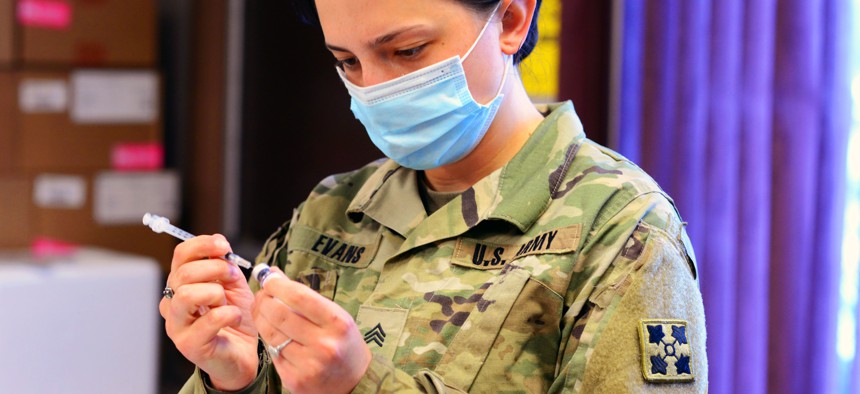ELIZABETH HOWE

The U.S. Army’s COVID-19 response leaders had plenty to say about its successes in the face of the pandemic, but also readily identified one facet of the operation where they failed.
“We blew it in a lot of ways. And the biggest lesson learned is the value of strategic communications,” Paul Ostrowski said during the U.S. Army Association’s annual conference this week. Ostrowski, who recently retired as a three-star, served on Operation Warp Speed as director of supply, production and distribution for the program.
Ostrowski said OWS staff estimated—from the “politics,” “social media,” and “surveys” —that around half of Americans were going to get the vaccine. Another 20 percent were “anti-vaxxers” who were never going to get the vaccine. And another 30 percent of Americans fell into the “moveable middle.”
“Where we failed was the movable middle, and we’re paying that price today,” he said.
He said that neither OWS nor the U.S. Army were specifically tasked with strategic communications efforts, which fell to “other entities within the executive branch architecture.”
Still, Ostrowski and others involved in the effort said the Army needs to do better, by “understanding the power of social media” and orchestrating a “coordinated effort” between Army Cyber, G2, and the Army’s chief of public affairs.
“We have to have a synergistic, coordinated approach and not just be on the offensive but also on the defense,” Army Surgeon General Lt. Gen. Scott Dingle said. “And that’s one of the lessons that we’ve learned through this COVID environment.”
Strategic communications were also complicated because issues related to COVID-19 were highly politicized—and the Army must still remain apolitical in its efforts, said Todd Semonite, who served as the Chief of Engineers and Commanding General of the U.S. Army Corps of Engineers during the early stages of the pandemic.
“The best advice I can give is ‘stay in your lane’,” Semonite said in response to a question about navigating the politicization of COVID-19. “We as DoD are apolitical. We don’t have an opinion one way or the other on political decisions. We execute those decisions that come down, and at the end of the day we've got to continue to be able to make sure we don't get caught in the middle.”
How exactly the Army plans to gain the strategic communications edge while also remaining apolitical was unclear.
“Social media has completely changed the landscape of this country, and frankly, the world. And until we get ahead of that, until we take that on as another domain, we're going to continue to be challenged in that particular arena,” Ostrowski said. “And that is our biggest failure. The fact that we did not follow through with an effective strategic campaign to move the movable middle from the left side, i.e. not getting the vaccine, into the correct side, getting a vaccine.”
Ostrowski still said the Army needs to do better at strategic communications—and not just for pandemic response.
“The piece that we always seem to fail to take into account is the nuts and bolts of fighting is the strategic communications piece. We continue to fail in that particular venue no matter what,” he said.
No comments:
Post a Comment